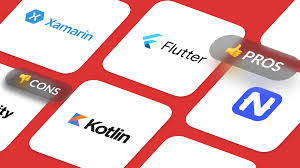Top Hybrid Frameworks for Building Hybrid Applications in 2025
The landscape of hybrid app development is constantly evolving. In 2025, several frameworks stand out for their performance, features, and community support. This article explores some of the top contenders, highlighting their pros and cons to help you choose the best framework for your next project.
1. React Native
React Native, backed by Meta (formerly Facebook), remains a dominant force. Its component-based architecture, leveraging JavaScript and React, allows for efficient cross-platform development targeting iOS and Android. Performance has significantly improved over the years, thanks to advancements in bridging technologies.
Pros:
- Large Community & Ecosystem: Extensive documentation, third-party libraries, and community support make troubleshooting and development smoother.
- Fast Development: Code reusability and hot reloading capabilities accelerate the development process.
- Native-like Performance: While not truly native, React Native achieves impressive performance, especially with optimized code.
Cons:
- Debugging Challenges: Debugging can be more complex than native development, requiring familiarity with both JavaScript and native debugging tools.
- Platform-Specific Code: While aiming for cross-platform compatibility, you might still need platform-specific code for certain features.
Example (JavaScript):
|
|
2. Flutter
Flutter, Google’s UI toolkit, has gained immense popularity. Using the Dart programming language, it compiles to native ARM code, resulting in exceptional performance. Its rich set of widgets and hot reload feature significantly streamline development.
Pros:
- Excellent Performance: Flutter apps often exhibit performance comparable to native apps.
- Beautiful UI: Flutter’s widget system allows for the creation of visually appealing and highly customizable UIs.
- Cross-platform Consistency: Flutter ensures consistent UI and UX across platforms.
Cons:
- Relatively Newer Ecosystem: While growing rapidly, Flutter’s ecosystem is still maturing compared to React Native.
- Dart Learning Curve: Developers need to learn Dart, which can represent a learning curve for those unfamiliar with it.
Example (Dart):
|
|
3. Ionic
Ionic is a powerful framework utilizing web technologies (HTML, CSS, and JavaScript) to build hybrid apps. It leverages Capacitor or Cordova for native functionalities. This approach allows for rapid development and easier integration with existing web projects.
Pros:
- Web Technology Familiarity: Developers proficient in web technologies can quickly get started.
- Large Component Library: Ionic provides a vast collection of pre-built components and UI elements.
- Easy Integration with Existing Web Apps: Ideal for extending web applications to mobile.
Cons:
- Performance Limitations: Performance might be slightly less optimal compared to Flutter or React Native, especially for complex apps.
- Dependence on Plugins: Accessing native device features relies on plugins, which may not always be available or well-maintained.
Example (HTML, CSS, JavaScript):
|
|
Conclusion
The best hybrid framework for your project depends on specific needs and priorities. React Native remains a strong contender due to its mature ecosystem. Flutter shines with its performance and elegant UI. Ionic offers a rapid development path using familiar web technologies. Careful consideration of these factors will lead to informed decision-making for your hybrid app development endeavors.
